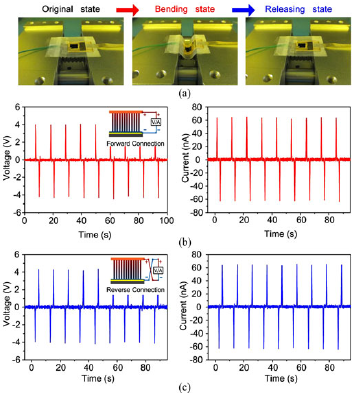 压电效应和热释电效应
常用的材料:
压电效应和热释电效应
常用的材料:
- ZnO,
- PZT lead ziconate titanate,
- PMN-PT lead magnesium niobate-lead titanate,
上边都是无机的
下边应该是有机的吧 - PVDF及其聚合物 polyvinylidene fluoride or its copolymers
The freestanding nanowire array was synthesized by nanoimprinting via infiltration of P(VDF-TrFE) polymer melt into the anodic aluminum oxide (AAO) nanochannels and subsequent removal of the template 优点:能通过商业中获取不同大小的纳米模板
制备
A, 材料准备10 wt% 的PVDF溶液, 将P(VDF-TrFE)粉末加入到DMF中,在60摄氏度下搅拌1h。
在Kapton基底上溅射一层Au(使用explorer multi-target sputtering system (Denton Vacuum)),之后在丙酮,酒精,去离子水中清洗,之后干燥。 将溶液spin-coating到Au-Kapton基底上,500r/min 60s 之后再120摄氏度下干燥2h取出DMF溶液。 商用的AAO纳米多孔模板, 400nm孔径,5um孔长 最后导电聚合物PEDOT:PSS 1wt%, 做上表面电极

B, 材料制备 先将P(VDF-TrFE) 旋涂到基底上 4-5um,之后蒸发溶剂DMF。
将AAO模板轻压到P(VDF-TrFE)薄膜上,在170摄氏度下维持1h,比P(VDF-TrFE)的熔点稍微高一点。 之后再120度下退火1h得到结晶体,之后缓慢冷却到室温。
最后将AAO溶解掉:
- 在2mol/L的CuCl2水溶液和 36wt%的HCl溶液混合溶液下,两者体积比为(2:1), Al的厚度~200um,在5-6min后可完全去除。
- 在4mol/L的NaOH溶液中 30-40min中溶解氧化铝
- Au/Kapton, which acts as the bottom electrode,
- P(VDF-TrFE) nanowire array as the piezoelectric
- pyroelectric material and PEDOT: PSS conducting polymer as the top electrode, as shown in Fig. 1(e).
材料表征
X-RD图像SEM图像 电压测量: 示波器
电流:low-noise current preamplifier (Model No. SR570, Stanford Research Systems, Inc.). 红外激光器(XI’AN SAPLING LASER)周期性改变温度
thermal infrared imager (FLIR SC7300-M)热红外成像仪记录温度数据 连接10~100兆欧的电阻,测试输出电压 在测量输出时: 用的是水平弯曲和拉直,没在竖直方向上施加形变 测量的变量: 形变大小,形变速度: 没有给出过多的解释
 测量热电效应: pyroelectric
激光器周期性改变温度,热红外成像仪实时监测温度。
测量热电效应: pyroelectric
激光器周期性改变温度,热红外成像仪实时监测温度。 解释:
解释:Once the infrared radiation was switch on, the oscillation of the dipoles in the P(VDF-TrFE) is increased due to the absorption of thermal energy, which causes the net surface polarization at the top electrode to decrease, resulting in a positive pyroelectric output.
Similarly, turning off the infrared laser causes cooling of polarized regions in the P(VDF-TrFE), which leads to an enhanced surface polarization, and is recorded as a negative peak.